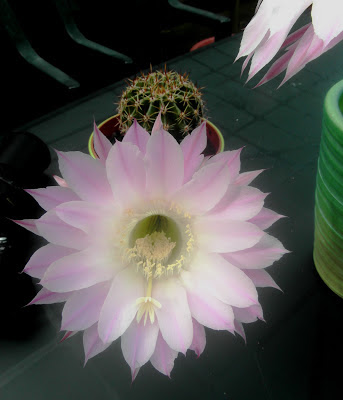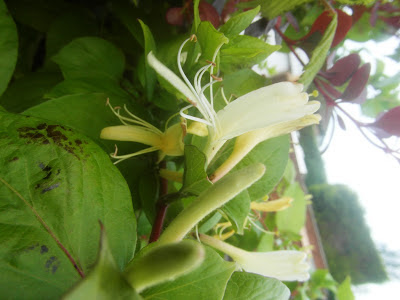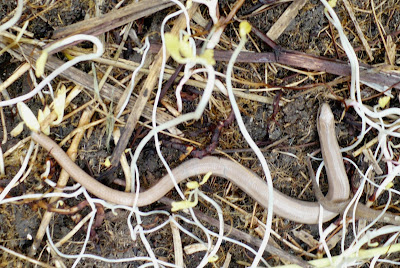
This blog may help people explore some of the 'hidden' issues involved in certain media treatments of environmental and scientific issues. Using personal digital images, it's also intended to emphasise seasonal (and other) changes in natural history of the Swansea (South Wales) area. The material should help participants in field-based modules and people generally interested in the natural world. The views are wholly those of the author.
Sunday 30 June 2013
Friday 28 June 2013
Seeing the Changes 595
Lots happening around the Bynea cycle path with the flowering of White melilot (Melilotus alba). I also noted a Common green shield bug (Palomina prasina) and active Black garden ants (Lasius niger). A cyanide-impregnated Six-spot burnet moth (Zygaena filipendulae) refueled at a Creeping thistle. Poison-incorporating larvae were also active with Depressaria daucella feasting in its hammock on Hemlock and Cinnabar moth munching Ragwort.
Thursday 27 June 2013
Tuesday 25 June 2013
Monday 24 June 2013
Sunday 23 June 2013
Saturday 22 June 2013
Friday 21 June 2013
Thursday 20 June 2013
Bypass Conservation
Whilst jogging back along the bypass between Llanelli and Loughor, I was forcibly reminded of just how much of the UK's nature inhabits the verges of the roads. I have never seen such a density of orchids [mainly Southern marsh orchids (Dactylorhiza praetermissa) but including some nice Bee orchids (Ophyys apifera)]. There was also the white variant of the Slender thistle (Carduus tenuifloris) and lots of Tufted vetch (Vicia cracca). Cars do protect some interesting stuff (so long as motorway 'gardening' is done sensitively).
Monday 17 June 2013
Sunday 16 June 2013
Friday 14 June 2013
Patently Absurd!
I am somewhat relieved that a US court has ruled that 'naturally-occurring human DNA' cannot be patented, over-turning earlier rulings (http://www.guardian.co.uk/law/2013/jun/13/supreme-court-genes-patent-dna). The companies that seek such patents argue that they are needed to cover the high costs of undertaking the associated research but new technology is actually making such studies much quicker and cheaper. The downside of such patents is that they block attempts to develop alternative tests and create a monopoly situation with respect to the charging of patients (putting some tests out of the reach of the poor). I also feel that elements that have naturally evolved (as opposed to artificially created DNA) should not be claimed by any one group. It does, however, raise the issue of whether drugs extracted from animals and plants should be patented?
Moggie Evolution?
The BBC programme on 'the private life of the domestic cat' (Felis catus) was certainly an interesting first stab (http://www.bbc.co.uk/mediacentre/latestnews/2013/secret-life-of-the-cat.html) although I think this limited tracking study of cats in a single English village was hardly an 'experiment'. In my eyes, a better description would be a 'limited, largely descriptive, study'. Although it is true that new technology can help us interpret the behaviour of organisms more effectively (there are devices that would have given more detailed descriptions of what the cats actually do as they roam the environs). My biggest reservation, however, is the highly speculative claim that cats my be 'evolving', moving away from their natural wild tendencies of hunting and territorial activity and emphasising their 'kittenish' characteristics that are more suitable to becoming a valued 'pet'. 'Evolution' implies natural selection meaning that cats with the favoured characteristics would tend to leave more copies of their genes in the next generation than 'wilder' counterparts. Humans, however, might well select lines of cats that make good pets (which would be artificial selection). They also often neuter their feline friends (hardly conducive to subsequent evolving). It could also be the case that different groups of humans would favour different characteristics in their cats (e.g. many farm cats were prized for their abilities to kill rats and mice that infested grain stores- people also tended to pass on the kittens of such cats to friends- again, a form of artificial selection). Cats certainly exploit their human hosts in a multitude of ways.
Thursday 13 June 2013
Tuesday 11 June 2013
Monday 10 June 2013
Sunday 9 June 2013
Seeing the Changes 584
The continued hot weather has sent plants into overdrive. In Penclacwydd, Dog rose (Rosa canina), Slender thistle (Carduus tenuifloris) and Common figwort (Scrophularia nodosa) were all in bloom. In Bynea, there were the first sightings of Self-heal (Prunella vulgaris), Ribbed melilot (Melilotus officinalis) and Biting stonecrop (Sedum acre).
Subscribe to:
Posts (Atom)
What's In a Critter's Name? 3. Cockchafer
Because of its time of appearance, the Cockchafer ( Melolontha melolontha ) is also known as the Maybug. A 'chafer' is an insect th...

-
The UK government continue their quest to turn England's rivers back into sewers. They first facilitated the privatised water companies...
-
Garden plants in France, The Netherlands, The UK and Sikkim (NE India).
+in+dunes+Horton.jpg)

+close+up+Loughor.jpg)























+Crymlyn+Burrows.jpg)












+kitten+Edale+YHA.jpg)
+North+Gower.jpg)
+Bynea.JPG)










